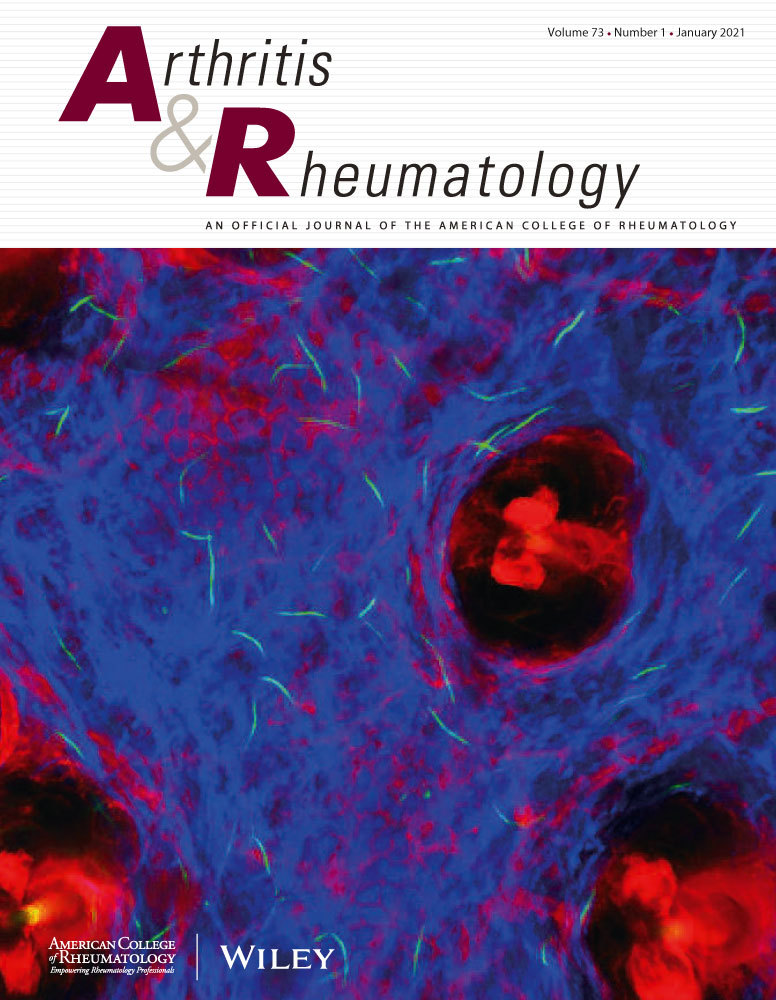anakinra和canakinumab在VEXAS综合征患者中的比较疗效和安全性-一项国际多中心研究
IF 10.9
1区 医学
Q1 RHEUMATOLOGY
引用次数: 0
摘要
目的:本研究的目的是比较anakinra和canakinumab治疗VEXAS综合征的临床反应、药物生存期和不良事件发生率的差异。方法这项多中心国际研究包括来自法国、以色列和意大利的VEXAS患者,他们接受了il - 1抑制(IL1i)治疗。总体反应(GR)定义为没有炎症症状,类固醇剂量和c反应蛋白减少50%或更多。采用多元回归分析确定相关变量。药物生存分析采用Kaplan-Meier图和log-rank检验,相关因素采用cox回归模型。结果纳入47例男性VEXAS患者;44名患者接受阿那单抗治疗,9名患者接受canakinumab治疗,6名患者在不同时间点同时使用这两种药物。anakinra 1个月时的GR为34%,canakinumab为100% (p<0.001), 3个月时分别为22%和78% (p=0.001)。在多变量分析中,canakinumab治疗与3个月时达到GR的较高比值比(OR)相关(OR 28.8, 95%CI 3.0 - 27.9, p=0.004)。canakinumab 300 mg/月的中位药物生存期为54(30-56)个月,而canakinumab 150 mg/月为7(4-8)个月,anakinra为1(1-2.5)个月(p=0.01)。只有阿那白拉组有注射部位反应(47% vs 0%, p=0.006),而阿那白拉组感染发生率更高(31%和11%,p= 0.3)。结论:与anakinra相比,scanakinumab表现出更好的临床反应和药物生存期,不良事件较少。每月Canakinumab 300mg可被认为是一种有效的保留类固醇的治疗选择。本文章由计算机程序翻译,如有差异,请以英文原文为准。
Comparative efficacy and safety of anakinra and canakinumab in patients with VEXAS syndrome - an international multicenter study.
OBJECTIVES
The aim of this study was to compare differences in clinical response, drug survival, and adverse event rates between anakinra and canakinumab in VEXAS syndrome.
METHODS
This multicenter international study includes VEXAS patients from France, Israel, and Italy treated with IL1 inhibition (IL1i). Global response (GR) was defined as the absence of inflammatory symptoms, 50% or greater decrease in steroid dose and C-reactive protein. Multiple regression analysis was performed to identify associated variables. Drug survival was analyzed using Kaplan-Meier plots and log-rank test, with Cox-regression models for associated factors.
RESULTS
We included 47 male VEXAS patients; 44 received anakinra, and 9 received canakinumab, with 6 patients using both at different time points. GR at 1 month was 34% for anakinra and 100% for canakinumab (p<0.001), 22% and 78% at 3 months, respectively (p=0.001). Treatment with canakinumab was associated with higher odds ratio (OR) of achieving GR at 3 months (OR 28.8, 95%CI 3·0-273·9, p=0.004) in a multivariable analysis. Median drug survival was 54 (30-56) months for canakinumab at 300 mg/month, compared to 7 (4-8) months for canakinumab 150 mg/month and 1 (1-2.5) months for anakinra (p=0.01). Injection site reactions were only recorded for the anakinra group (47 vs 0%; p=0.006), whereas infections were more frequent in the anakinra group (31% and 11%; p=0·3).
CONCLUSIONS
Canakinumab demonstrated superior clinical response and drug survival with fewer adverse events compared to anakinra. Monthly Canakinumab 300 mg may be considered as an effective steroid-sparing therapeutic option for VEXAS patients.
求助全文
通过发布文献求助,成功后即可免费获取论文全文。
去求助
来源期刊

Arthritis & Rheumatology
RHEUMATOLOGY-
CiteScore
20.90
自引率
3.00%
发文量
371
期刊介绍:
Arthritis & Rheumatology is the official journal of the American College of Rheumatology and focuses on the natural history, pathophysiology, treatment, and outcome of rheumatic diseases. It is a peer-reviewed publication that aims to provide the highest quality basic and clinical research in this field. The journal covers a wide range of investigative areas and also includes review articles, editorials, and educational material for researchers and clinicians. Being recognized as a leading research journal in rheumatology, Arthritis & Rheumatology serves the global community of rheumatology investigators and clinicians.
 求助内容:
求助内容: 应助结果提醒方式:
应助结果提醒方式:


